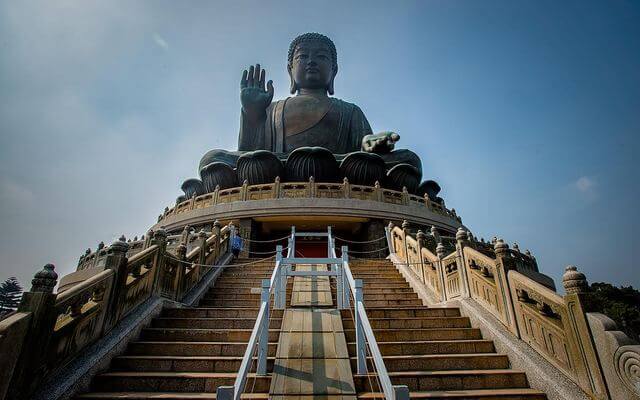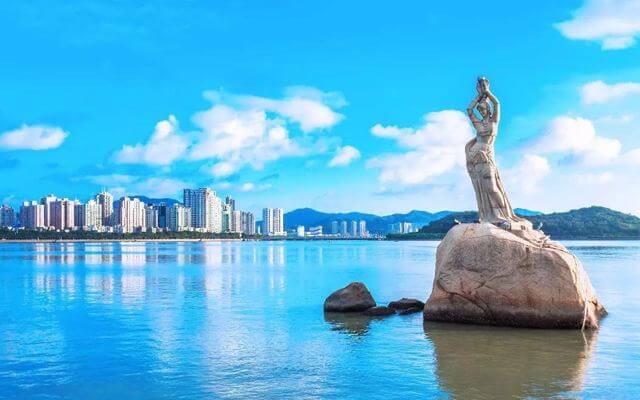Chinese sculpture is an important part of Chinese culture. From the early ancient pottery and clay sculptures to the bronze ceremonial terracotta warriors and horses sculptures to today’s urban sculptures, each period has its own splendor. Do you know what are the famous sculptures in China? What is the representative of Shanghai sculpture? This article brings you the top ten sculptures in China.
1. The Big Buddha 天坛大佛

The Big Buddha is the tallest outdoor bronze sitting Buddha in the world. It sits majestically on the Muyu Peak on Lantau Island in Hong Kong at an altitude of 482 meters. This majestic and magnificent Buddha, which was built by the Po Lin Monastery and was completed in 12 years, symbolizes the stability and prosperity of Hong Kong, the country and the people, and the world peace. The Big Buddha is an important landmark in Hong Kong, attracting many Chinese and foreign believers and tourists to come to worship and visit. In addition to being an outstanding project, the Tian Tan Buddha is an outstanding achievement of modern Buddhist sculpture art, and it is also a precious cultural heritage of mankind.
2. Zhuhai Fisher Girl Statue 珠海渔女雕像

The statue of Zhuhai Fisher Girl, built in 1982, is located on the banks of the beautiful Xianglu Bay in Zhuhai. It is a symbol of Zhuhai city and a famous tourist attraction in Zhuhai. The statue is composed of 10 tons of granite stone, divided into 70 pieces, and has a height of 9.9 meters. The fisher girl has an elegant posture and a joyful expression. The image of the fisher girl originated from a beautiful love legend in Zhuhai. The successful creation of the fisher girl statue created the first of China’s large seaside statues.
Address: No. 63 Lover Middle Road, Xiangzhou District, Zhuhai City, Guangdong Province
3. Sanya Nanhai Guanyin 三亚南海观音
Standing Statue of Guanyin in the South China Sea The statue of Guanyin on the sea in Nanshan, Sanya, was chosen by Zhao Puchu, the former president of the Chinese Buddhist Association. Zhao Puchu, the chairman of the Chinese Buddhist Association, gladly titled the icon-“South China Sea Guanyin”. The Nanshan Sea Guanyin Image Project began preparations in 1995, was approved in 1999 and broke ground in the same year, with a total investment of 800 million yuan. Guanyin Bodhisattva represents compassion in Buddhism. It mainly assists Buddha Amitabha in the Western Paradise to accept his death, and helps Buddha Shakyamuni in the real world to promote his enlightenment in the real world. The Jingzhao Project is known as a “world-class, century-class” Buddhist project because of its grand scale, great significance, and rich Buddhist heritage.
4. The Central Plains Buddha 中原大佛
The Central Plains Buddha, located in Shangtang Foquan Temple, Zhaocun Township, Lushan County, Pingdingshan City, Henan Province, is currently the world’s tallest Buddhist statue. It was designed and produced in 1997 by Master Lin Shengbiao, Putian Xingsheng Craft, National Intangible Cultural Heritage Technology Inheritor, and Vice President of Fujian Arts and Crafts Masters Association. The total height of the Buddha is 208 meters, the height is 108 meters, the lotus seat is 20 meters high, the Vajra seat is 25 meters high, and the Xumi seat is 55 meters high. The Tianrui Auspicious Golden Bell in the scenic area has a net weight of 116 tons and is the “world’s largest outside strike bronze cast bell” included in the Guinness Book of World Records.
5. Rusanna Buddha 卢舍那大佛
The Lucena Buddha was created in the image of Wu Zetian in the fourth year of Emperor Gaozong’s Xianheng in the Tang Dynasty, that is, in 672 AD. It is located in Fengxian Temple on the southern mountainside of Longmen Xishan in Luoyang. The height is 17.14 meters. It is the highest artistic level and overall design in the Longmen Grottoes. The most rigorous and largest place. According to scholars’ research, the construction of the entire large niche will take at least 15 years.
6. The statue of the maid in Jinci Temple of Our Lady 晋祠圣母殿侍女像
“The Statue of the Maid in the Temple of Our Lady of Jinci”, a colored sculpture, was made during the Yuanyou period of the Northern Song Dynasty, about 1082. It is located in the Temple of Our Lady of Jinci, 25 kilometers southwest of Taiyuan City, Shanxi Province. There are more than forty painted statues in the Sanctuary of Our Lady, all of them from the Northern Song Dynasty. The seated statue of the Virgin is in the center, 2.28 meters high, with a phoenix crown and python robe, dignified, surrounded by many female officials and maids. Their movements and postures are different, and their demeanor and character are portrayed very vividly and naturally. They are the most outstanding group of figures in the Jinci colored sculptures.
7. Mud boy 泥孩儿
Clay toys were very popular in the Song Dynasty. Although the clay figures were small, they were exquisite and vivid. They provided research materials for Song Dynasty art, folk customs, and costumes. In the Song Dynasty Meng Yuan’s “Tokyo Dream Hualu”, every Chinese Valentine’s Day in the Northern Song Dynasty, the streets “all sell milling and drinking music, they are small plastic earthen ears. They are decorated with carved wood, or decorated with red veil and green cages, or decorated with There is a pair of gold pearls and teeth worth thousands of.” The mud boy of the Song Dynasty was very valuable at that time.
8. Huayan Temple Gasshotooth Bodhisattva 华严寺合掌露齿菩萨
Huayan Temple Gasshotooth Bodhisattva is in the Bodhisattva Tibetan Hall of Huayan Temple. This statue was praised by Guo Moruo as Oriental Venus. The four great bodhisattvas sit on the ascendant seat, demure and dignified. The other images are also richly decorated with natural posture. The four corners are equipped with a guardian vajra, which is magnificent and mighty. Among them, the Bodhisattva (pictured on the right) is the most vivid, with a plump face, a beautiful posture, and a smile with the palms together. It is a treasure of the Liao Dynasty painted sculpture art.
9. Pottery figurines of the Eastern Han Dynasty playing drums and singing 东汉击鼓说唱陶俑
The pottery figurines of the Eastern Han Dynasty drumming and singing were unearthed from the Hanya Tomb of Tianhui, Chengdu, Sichuan Province in 1957. They are Ming artifacts of the Eastern Han Dynasty and are now in the National Museum of China. The pottery figurines are 56 cm high and made of muddy gray pottery. They wear a silk on their head, shoulders are high, they are barefoot in pants, and a flat drum is wrapped around their left arm. The right hand raises the mallet to strike, giggling, humorous and exaggerated. Live the image of Haiyu being rap. The pottery figurines of the Eastern Han Dynasty drumming and singing are called “the first figurines of the Han Dynasty”. It is an excellent sculpture with a strong folk atmosphere and local features, and it is a national first-class cultural relic.
10. Copper running horse 铜奔马
The bronze running horse was unearthed from the tomb of the Eastern Han Dynasty (25-220 AD) in Leitai, Wuwei City, Gansu Province in 1969, about 1,600 years ago. Ma Tong is 34.5 cm high and 45 cm long. The Flying Swallow Horse, as an exquisite artwork, is the best testimony of our country’s long history and splendid culture. It has been exhibited abroad many times. Its extraordinary charm has dumped countless foreign audiences. Its popularity has made it selected as a symbol of Chinese tourism.